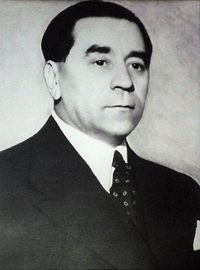Gheorghe Tătărescu
Prime minister
For the artist, see Gheorghe Tattarescu.Gheorghe I. Tătărescu (also known as Guţă Tătărescu, with a slightly antiquated pet form of his given name; 2 November 1886 – 28 March 1957) was a Romanian politician who served twice as Prime Minister of Romania (1934–1937; 1939–1940), three times as Minister of Foreign Affairs (interim in 1934 and 1938; appointed to the office in 1945-1947), and once as Minister of War (1934). Representing the "young liberals" faction inside the National Liberal Party (PNL), Tătărescu began his political career as a collaborator of Ion G. Duca, becoming noted for his anti-Communism and, in time, for his conflicts with the PNL's leader Dinu Brătianu and the Foreign Minister Nicolae Titulescu. During his first time in office, he moved closer to King Carol II, leading an ambivalent policy toward the fascist Iron Guard and ultimately becoming instrumental in establishing the authoritarian and corporatist regime around the National Renaissance Front. In 1940, he accepted the cession of Bessarabia and Northern Bukovina to the Soviet Union, and consequently had to resign.After the start of World War II, Gheorghe Tătărescu initiated a move to rally political forces in opposition to Ion Antonescu's dictatorship, and sought an alliance with the Romanian Communist Party (PCR). He was twice expelled from the PNL, in 1938 and 1944, creating instead his own group, the National Liberal Party-Tătărescu, and representing it inside the Communist-endorsed Petru Groza cabinet. In 1946-1947, he was also the President of the Romanian Delegation to the Peace Conference in Paris. After that moment, relations between Tătărescu and the PCR began to sour, and he was replaced from the leadership of both his own party and the Foreign Ministry when his name was implicated in the Tămădău Affair. Following the Communist takeover, he was arrested and held as a political prisoner, while being called to testify in the trial of Lucreţiu Pătrăşcanu. He died soon after his release from prison.Elected an honorary member of the Romanian Academy in 1937, he was removed from his seat by the Communist authorities in 1948. One of his brothers, Colonel Ştefan Tătărescu, was at some point the leader of a minor Nazi group, the National Socialist Party.
Personal facts
| Alias (AKA) | Guţă Tătărescu |
|---|
| Birth date | November 02, 1886 |
|---|
| Birth place | Romania , Kingdom of Romania , Târgu Jiu |
|---|
| Nationality | |
|---|
| Religion | |
|---|
| Date of death | March 28, 1957 |
|---|
| Place of death | Romania , Socialist Republic of Romania , Bucharest |
|---|
| Profession | |
|---|
